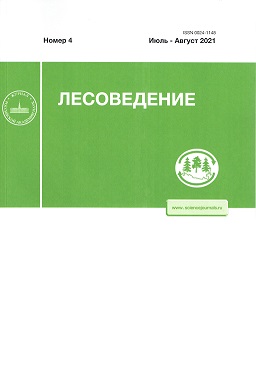ISSN: 0024-1148 Russian Journal of Forest Science. 2014, No. 3, pp. 31-38
T. T. Efremova, A. F. Avrova
Forest Institute, Siberian Branch of the Russian Academy of Sciences
Academgorodok 50 bldg. 28, Krasnoyarsk, 660036, Russia
E-mail: efr2@ksc.krasn.ru
Received 12 February 2006
For the first time for forested wetlands the peat soils were evaluated for the purpose of meliorative value. Morphometric parameters of needles were shown to be helpful in forest melioration practice. This is affordable, simple and effective indicators for the site class of natural unmanaged wetland pine stands and for the estimation of draining effectiveness.
- Acknowledgements: This work was supported by the International Science and Technology Center (project no. 4079).
- Keywords: wetland pine stands, site class, forest melioration, land evaluation.
REFERENCES
- Sokolov A.V., Agrokhimicheskie metody issledovaniya pochv (Agrochemical techniques of soil studies), Moscow: Nauka, 1975, 656 p.
- Astapov S.V., Meliorativnoe pochvovedenie (Meliorative soil science), Moscow: Nauka, 1958, 367 p.
- Vaichis M., Rutkauskas A., Shkala otsenki plodorodiya lesnykh pochv i proizvoditel'nosti nasazhdenii (The forest soil fertility and the forest stands performance assessment scale), Kaunas: Izd-vo LitNIILKh, 1973, 8 p.
- Ginzburg K.E., Shcheglova G.M., Vul'vius E.A., Uskorennyi metod szhiganiya pochv i rastenii (A shortcut method of soil and plant burning), Pochvovedenie, 1963, No. 5, pp. 89-96.
- Dospekhov B.A., Metodika polevogo opyta (s osnovami statisticheskoi obrabotki rezul'tatov issledovaniya) (Methods of the field experiment (with the basics of statistical evaluation of study results)), Moscow: Kolos, 1973, 336 p.
- Zgurovskaya L.N., Issledovanie khvoi sosny i kedra na bolotakh raznykh tipov (Study of the needle morphology of pine and siberian pine from various wetland types), Botanicheskii zhurnal, 1965, Vol. 50, No. 2, pp. 234-237.
- Efremov S.P., Estestvennoe zalesenie osushennykh bolot lesnoi zony Zapadnoi Sibiri (Natural afforestation of the drained wetlands in the forest zone of Western Siberia), Moscow: Nauka, 1972, 155 p.
- Efremova T.T., Gumusnoe sostoyanie pochv bolotnykh sosnyakov Zapadnoi Sibiri (Humic status of the soils of boggy pine forests of the West Siberia), In: Pochvy sosnovykh lesov Sibiri (Soils of the pine forests of Siberia), Krasnoyarsk: Izd-vo ILiD SO AN SSSR, 1986, pp. 33-46 (121 p.).
- Efremova T.T., Efremov S.P., Cherkashin V.P., Troficheskaya otsenka lesovodstvennoi produktivnosti torfyanykh pochv Zapadnoi Sibiri (Trophic assessment of silvicultural productivity of the peat soils of Western Siberia), Sibirskii biologicheskii zhurnal, 1993, No. 6, pp. 41-48.
- Efremova T.T., Efremov S.P., Cherkashin V.P., Svyaz' proizvoditel'nosti bolotnykh sosnyakov Zapadnoi Sibiri s pochvennymi usloviyami (Links between paludified pine stands performance and soil properties in Western Siberia), Lesovedenie, 1995, No. 2, pp. 50-59.
- Efremova T.T., Efremov S.P., Melent'eva N.V., Cherkashin V.P., Otsenka plodorodiya lesnykh torfyanykh pochv Zapadnoi Sibiri metodami rastitel'noi diagnostiki (Estimation of the forest peat soils fertility in Western Siberia with the plant diagnostics methods), Pochvovedenie, 1996, No. 7, pp. 879-887.
- Efremova T.T., Ovchinnikova T.M., Sukhovol'skii V.G., Avrova A.F., Efremov S.P., Opyt primeneniya metodov mnogomernogo statisticheskogo analiza dlya gruppirovki tipov uslovii proizrastaniya bolotnykh sosnyakov Zapadnoi Sibiri (Application of the multivariate statistical analysis to classify site conditions of the paludified pine forests of Western Siberia), Lesovedenie, 2002, No. 2, pp. 53-62.
- Konstantinov V.K., Krasil'nikov N.A., Khitrin S.V., Sovremennoe sostoyanie gidrolesomelioratsii: aktual'nye prakticheskie i nauchnye zadachi (Current state of hydrological forest melioration: urgent applied and theoretical objectives), Bogs and boggy forests in terms of sustainable exploitation of natural resources, Proc. Conf., 1999, pp. 261-264.
- Korchagina M.P., Morfometricheskaya kharakteristika khvoi sosny obyknovennoi na osushennykh torfyanykh pochvakh (Morphometric description of the Scots pine needles growing on the drained peatland soils), In: Izmenenie lesobolotnykh biogeotsenozov pod vliyaniem osusheniya (Alterations of boggy forest biogeocoenoses affected by drainage), Petrozavodsk: Izd-vo Karel'skogo filiala AN SSSR, 1986, pp. 62-82 (212 p.).
- Melent'eva N.V., Pochvy osushennykh lesnykh bolot (Soils of the drained forest mires), Novosibirsk: Nauka, 1980, 128 p.
- Orlov A.Y., Koshel'kov S.P., Pochvennaya ekologiya sosny (Soil ecology of the pine), Moscow: Nauka, 1971, 323 p.
- Porgasaar V.I., Diagnostika mineral'nogo pitaniya sosny obyknovennoi (Diagnostics of mineral nutrition of Scots pine), Agrokhimiya, 1977, No. 5, pp. 120-127.
- Prokushkin S.G., Mineral'noe pitanie sosny (Mineral nutrition of the pine), Novosibirsk: Nauka, 1982, 190 p.
- Chekotovskii E.V., Graficheskii analiz statisticheskikh dannykh v Microsoft Excel 2000 (Grafical analysis of statistical data in Microsoft Excel 2000), Moscow: Vil'yams, 2000, 464 p.
- Amponsach I.G., Comeau P.G., Brockley R.P., Lieffers V.J., Effects of repeated fertilization on needle longevity, foliar nutrition, effective leaf area index. and growth characteristics of lodgepole pine in interior British Columbia, Canada, Canadian Journal of Forest Research, 2005, Vol. 35, No. 2, pp. 440-451.
- Ohlson M., Growth and nutrient characteristics in bog and fen populations of Scots pine (Pinus sylvestris), Plant and Soil, 1995, Vol. 172, No. 2, pp. 235-245.
- Wehrmann J., Metodische Untersuchungen zur Durohfuhrung von Nadelanalysen in Kiefernbestanden, Forstwissenschaftliches Centralblatt, 1959, Vol. 78, No. 3-4, pp. 70-83.
- Wheeler B.D., Shaw S.C., Cook R.E.D., Phytometric assessment of the fertility of underained rich-fen soils, Journal of Applied Ecology, 1992, Vol. 29, No. 2, pp. 466-475.
- Yang R.C., Foliage and shard growth responses of semimature lodgepole pine to thinning and fertilization, Canadian Journal of Forest Research, 1998, Vol. 28, No. 12, pp. 1794-1804.
- Youngblood A., Ferguson D.E., Changes needle morphology of shade tolerant seedlings after partial overstory canopy removal, Canadian Journal of Forest Research, 2003, Vol. 33, No. 7, pp. 1315-1322.

